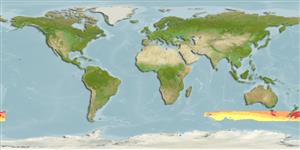>
Zeiformes (Dories) >
Oreosomatidae (Oreos) > Oreosomatinae
Etymology: Allocyttus: Greek, allos = other + Greek, kyttaros, kytos = a convex cavity; niger: niger refers to the blackish color of freshly caught specimens. It also reflects the common name "black oreo", which has been widely used in the New Zealand deepwater fishery for several years (Ref. 27159).
Environment: milieu / climate zone / depth range / distribution range
Ecología
marino batipelágico; oceanodromo (Ref. 51243); rango de profundidad 560 - 1300 m (Ref. 6390). Deep-water; 43°S - 55°S, 65°E - 174°W (Ref. 27159)
Southwest Pacific: New Zealand and Australian waters south of 43°S, and south of Tasmania at 47°S. Also Ref. 26139.
Length at first maturity / Tamaño / Peso / Age
Maturity: Lm ?, range 36 - ? cm
Max length : 47.0 cm TL macho / no sexado; (Ref. 6390); common length : 35.0 cm TL macho / no sexado; (Ref. 9258); peso máximo publicado: 1.5 kg (Ref. 6390); edad máxima reportada: 100 años (Ref. 27140)
Found close to the sea bed in deep water. Form large shoals over rough ground near pinnacles and canyons. Juveniles are pelagic and inhabit oceanic waters. They tend to be dispersed over smooth grounds (Ref. 6390). Feed mainly on salps and benthic crustaceans (Ref. 27150). Eggs float near the sea surface and larvae also inhabit surface waters (Ref. 6390). Based on trawl catch rates, there is no evidence of vertical migration during day or night (Ref. 27150).
Displays seasonally synchronised reproduction.
James, G.D., T. Inada and I. Nakamura, 1988. Revision of the oreosomatid fishes (Family Oreosomatidae) from the southern oceans, with a description of a new species. N.Z. J. Zool. 15:291-326. (Ref. 27159)
IUCN Red List Status (Ref. 130435)
Threat to humans
Harmless
Human uses
Pesquerías: comercial
Más información
ReferenciasAcuiculturaPerfil de acuiculturaRazasGenéticaElectrophoresesheritabilidadEnfermedadesProcesamientoNutrientsMass conversion
ColaboradoresImágenesStamps, Coins Misc.SonidosCiguateraVelocidadTipo de nataciónSuperficie branquialOtolitosCerebrosVisión
Herramientas
Special reports
Download XML
Fuentes de Internet
Estimates based on models
Preferred temperature (Ref.
123201): 2.1 - 6.8, mean 5.1 °C (based on 63 cells).
Phylogenetic diversity index (Ref.
82804): PD
50 = 0.5635 [Uniqueness, from 0.5 = low to 2.0 = high].
Bayesian length-weight: a=0.01413 (0.00715 - 0.02792), b=3.03 (2.85 - 3.21), in cm total length, based on LWR estimates for this species & (Sub)family-body (Ref.
93245).
Nivel trófico (Ref.
69278): 3.5 ±0.50 se; based on food items.
Generation time: 56.1 ( na - na) years. Estimated as median ln(3)/K based on 2
growth studies.
Resiliencia (Ref.
120179): Muy bajo, población duplicada en un tiempo mínimo superior a 14 años (tmax=100; tm=27; Fec >5,000).
Fishing Vulnerability (Ref.
59153): High to very high vulnerability (69 of 100).
Climate Vulnerability (Ref.
125649): Moderate vulnerability (40 of 100).
Nutrients (Ref.
124155): Calcium = 18.7 [5.3, 52.6] mg/100g; Iron = 0.306 [0.116, 0.992] mg/100g; Protein = 17.6 [14.8, 20.6] %; Omega3 = 0.159 [0.051, 0.456] g/100g; Selenium = 17.7 [4.6, 65.7] μg/100g; VitaminA = 38.3 [3.4, 451.8] μg/100g; Zinc = 0.581 [0.270, 1.279] mg/100g (wet weight);
